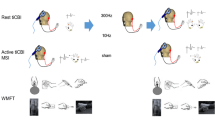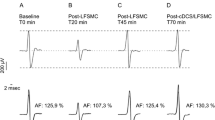Abstract
Clinical observations and data from animal experiments point to a physiological facilitatory influence of the deep cerebellar structures on the motor system through the cerebello-thalamo-cortical pathways. The aim of the present study was to explore the long-term effects of low-frequency (1 Hz) repetitive transcranial magnetic stimulation (rTMS) over the cerebellum on short intracortical inhibition (SICI) and facilitation (ICF) of the motor cortex in normal subjects. Eight healthy subjects (mean age 26.9 ± 3.1) underwent 1 Hz frequency rTMS delivered on the right cerebellar hemisphere. Before and after cerebellar rTMS, SICI and ICF were assessed in the motor cortex contralateral to the stimulated cerebellar hemisphere by means of a paired pulse paradigm with a conditioning subthreshold stimulus set to 80% of the motor threshold (MT) followed by a testing stimulus at 120% of MT intensity. Five different interstimulus intervals (ISIs) were used to assess SICI (2 and 4 ms) and ICF (7, 10 and 15 ms). Amplitude of the responses was expressed as the percentage of motor evoked potential (MEP) to test stimulus alone. Results showed a significant decrease of ICF at 10 ms ISI that persisted up to 20 min after cerebellar rTMS. This was the only significant modulatory effect of cerebellar stimulation on intracortical motor excitability A suppressive effect of the low-frequency TMS on Purkinje cells could be supposed, even if, the lack of effects on other facilitatory ISIs, stands for more complex modulatory effects of rTMS over cerebellum. The study is a further demonstration that rTMS over the cerebellum induces a long-lasting modulatory effect on the excitability of the interconnected motor area.





Similar content being viewed by others
References
Ando N, Izawa Y, Shinoda Y (1995) Relative contributions of thalamic reticular nucleus neurons and intrinsic interneurons to inhibition of thalamic neurons projecting to the motor cortex. J Neurophysiol 73:2470–2485
Brighina F, Daniele O, Piazza A, Giglia G, Fierro B (2006) Hemispheric cerebellar rTMS to treat drug-resistant epilepsy: case reports. Neurosci Lett 397:229–233
Chen R, Classen J, Gerloff C, Celnik P, Wassermann EM, Hallett M. Cohen LG (1997) Depression of motor cortex excitability by low-frequency transcranial magnetic stimulation. Neurology 48:1398–1403
Daskalakis ZJ, Paradiso JO, Christensen BK, Fitzgerald PB, Gunraj C, Chen R (2004) Exploring the connectivity between the cerebellum and motor cortex in humans. J Physiol 557:689–700
Di Lazzaro V, Restuccia D, Olivero A, Proficue P, Ferrara L, Insola A, Mazzone P, Tonali P, Rothwell JC (1998) Magnetic transcranial stimulation at intensities below active motor threshold activates intracortical inhibitory circuits. Exp Brain Res 119:265–268
Fitzgerald PB, Brown TL, Daskalakis ZJ, Chen R, Kulkarni J (2002) Intensity-dependent effects of 1 Hz rTMS on human corticospinal excitability. Clin Neurophysiol 113:1136–1141
Gerschlager W, Siebner HR, Rothwell JC (2001) Decreased corticospinal excitability after subthreshold 1-Hz rTMS over lateral premotor cortex. Neurology 57:449–455
Gerschlager W, Christensen LOD, Bestmann S, Rothwell JC (2002) rTMS over the cerebellum can increase corticospinal excitability through a spinal mechanism involving activation of peripheral nerve fibres. Clin Neurophysiol 113:1435–1440
Holdefer RN, Miller LE, Chen LL, Houk JC (2000) Functional connectivity between cerebellum and primary motor cortex in the awake monkey. J Neurophysiol 84:585–590
Ili’ c TV, Meintzschel F, Cleff U, Ruge D, Kessler KR, Ziemann U (2002) Short-interval paired-pulse inhibition and facilitation of human motor cortex: the dimension of stimulus intensity. J Physiol 545.1:153–167
Kaneko K, Kawai S, Fuchigami Y, Morita H, Ofuji A (1996) The effect of current direction induced by transcranial magnetic stimulation on the corticospinal excitability in human brain. Electroencephalogr Clin Neurophysiol 101:478–482
Kujirai T, Caramia MD, Rothwell JC, Day BL, Thompson PD, Ferbert A, Wroe S., Asselman P, Marsden CD (1993) Corticocortical inhibition in human motor cortex. J Physiol 471:501–519
Liepert J, Wessel K, Schwenkreis P, Trillenberg P, Otto V, Vorgerd M, Malin JP, Tegenthoff M (1998) Reduced intracortical facilitation in patients with cerebellar degeneration. Acta Neurol Scand 98:318–323
Maeda F., Keenan JP, Tormos JM, Topka H, Pascual-Leone A (2000) Modulation of corticospinal excitability by repetitive transcranial magnetic stimulation. Clin Neurophysiol 111:800–805
Maeda F, Gangitano M, Thall M, Pascual-Leone A (2002) Inter- and intra-individual variability of paired-pulse curves with transcranial magnetic stimulation (TMS). Clin Neurophysiol 113:376–382
Na J, Kakei S, Shinoda Y (1997) Cerebellar input to corticothalamic neurons in layers V and VI in the motor cortex. Neurosci Res 28:77–91
Nakamura H, Kitagawa H, Kawaguchi Y, Tsuji H (1997) Intracortical facilitation and inhibition after transcranial magnetic stimulation in conscious humans. J Physiol 498:817–823
Oliveri M, Koch G, Torriero S, Caltagirone C (2005) Increased facilitation of the primary motor cortex following 1 Hz repetitive transcranial magnetic stimulation of the contralateral cerebellum in normal humans. Neurosci Lett 376:188–193
Pascual-Leone A, Valls-Sole J, Wassermann EM, Hallett M (1994) Responses to rapid-rate transcranial magnetic stimulation of the human motor cortex. Brain 117:847–858
Restivo DA, Lanza S, Saponara R, Rapisarda G, Giuffrida S, Palmeri A (2002) Changes of cortical excitability of human motor cortex in spino-cerebellar ataxia type 2. A study with paired transcranial magnetic stimulation. J Neurol Sci 198:87–92
Rothwell JC (1996) The use of paired pulse stimulation to investigate the intrinsic circuitry of human motor cortex. In: Nilsson J, Panizza M, Grandori F (eds) Advances in magnetic stimulation. Mathematical modeling and clinical applications. Fondazione Salvatore Maugeri, Pavia, pp 99–104
Saito Y, Yokota T, Yuasa T (1995) Suppression of motor cortical excitability by magnetic stimulation of the cerebellum. Brain Res 691:200–206
Schambra HM, Savaki L, Cohen LG (2003) Modulation of excitability of human motor cortex (M1) by 1 Hz transcranial magnetic stimulation of the contralateral M1. Clin Neurophysiol 114:130–133
Schwenkreis P, Tegenthoff M, Withscher K, Börnke C, Przuntek H, Malin JP, Schöls L (2002) Motor cortex activation by transcranial magnetic stimulation in ataxia patients depends on the genetic defect. Brain 125:301–309
Smith MJ, Keel JC, Greenberg BD, Adams LF, Schmidt PJ, Rubinow DA, Wassermann EM (1999) Menstrual cycle effects on cortical excitability. Neurology 53:2069–2072
Stefan K, Kunesch E, Benecke R, Cohen LG, Classen J (2002) Mechanisms of enhancement of human motor cortex excitability induced by interventional paired associative stimulation. J Physiol 543:699–708
Tamburin S, Fiaschi A, Marani S, Andreoli A, Manganotti P, Zanette G (2004). Enhanced intracortical inhibition in cerebellar patients. J Neurol Sci 217:205–210
Théoret H, Haque J, Pascual-Leone A (2001) Increased variability of paced finger tapping accuracy following repetitive magnetic stimulation of the cerebellum in humans. Neurosci Lett 306:29–32
Ugawa Y, Uesaka Y, Terao Y, Hanajima R, Kanazawa I (1995) Magnetic stimulation over the cerebellum in humans. Ann Neurol 37:703–713
Van der Linden C, Bruggeman R (1993). Multiple descending corticospinal volleys demonstrated by changes of the wrist flexor H-reflex to magnetic motor cortex stimulation in intact human subjects. Muscle Nerve 16:374–378
Werhahn KJ, Taylor J, Ridding M, Meyer BU, Rothwell JC (1996) Effect of transcranial magnetic stimulation over the cerebellum on the excitability of human motor cortex. Electroencephalogr Clin Neurophysiol 101:58–66
Wessel K, Tegenthoff M, Vorgerd M, Otto V, Niyschke MF, Malin JP (1996) Enhancement of inhibitory mechanisms in the motor cortex of patients with cerebellar degeneration: a study with transcranial magnetic stimulation. Electroencephalogr Clin Neurophysiol 101:273–280
Ziemann U (1999) Intracortical inhibition and facilitation in the conventional paired TMS paradigm. Electroencephalogr Clin Neurophysiol 51(Suppl):127–136
Ziemann U, Rothwell JC, Ridding MC (1996) Interaction between intracortical inhibition and facilitation in human motor cortex. J Physiol 496:873–881
Ziemann U, Corwell B, Cohen LG (1998) Modulation of plasticity in human motor cortex after forearm ischemic nerve block. J Neurosci 18:1115–1123
Acknowledgments
This research was financed with MIUR funds to Brigida Fierro and Filippo Brighina.
Author information
Authors and Affiliations
Corresponding author
Rights and permissions
About this article
Cite this article
Fierro, B., Giglia, G., Palermo, A. et al. Modulatory effects of 1 Hz rTMS over the cerebellum on motor cortex excitability. Exp Brain Res 176, 440–447 (2007). https://doi.org/10.1007/s00221-006-0628-y
Received:
Accepted:
Published:
Issue Date:
DOI: https://doi.org/10.1007/s00221-006-0628-y




